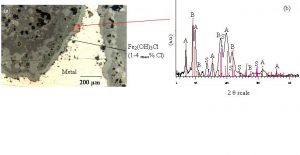D. Neff, P. Dillmann, L. Bellot-Gurlet*, G. Béranger**
One of the most important technological challenge of the century is the safe storage of nuclear wastes. In France, one part of the engineered barrier designed to separate the biosphere from wastes is a low alloy steel overpack. Thus, it is necessary to predict the very long term corrosion behaviour of this overpack for several centuries. For this purpose, in addition of modelling and laboratory simulating, it is necessary to look at corrosion products developed on archaeological analogues in comparable environments. A study made on iron archaeological artefacts buried in soil during several centuries is performed in the LPS.. Samples are taken on archaeological sites with the adhering soil and cross sections are made. Characterisation techniques are optical and electronic microscopes, Energy Dispersive Spectrometry coupled to Scanning Electron Microscopes, Electron Probe Micro Analyses, micro X-ray Diffraction under synchrotron radiation and micro Raman spectrometry. A specific terminology is proposed to describe the corrosion layout. The most identified corrosion layout is made of several ten micrometers zones of magnetite and/or maghemite embedded in a goethite matrix and forms in aerated soils. A corrosion mechanism is proposed in order to explain this profile. When the soil water contains more chlorine or carbonates and less dissolved oxygen some specific corrosion product appear as akaganeite, oxichlorides and siderite. * Laboratoire de Dynamique Interactions et Réactivité (LADIR), UMR 7075 CNRS – Université Pierre et Marie Curie Paris VI, 2 rue Henri Dunant, 94320 Thiais, France ** Université de Technologie de Compiègne, Laboratoire Roberval, Centre de Recherche de Royallieu, BP529, 60205 Compiègne Cedex, France






